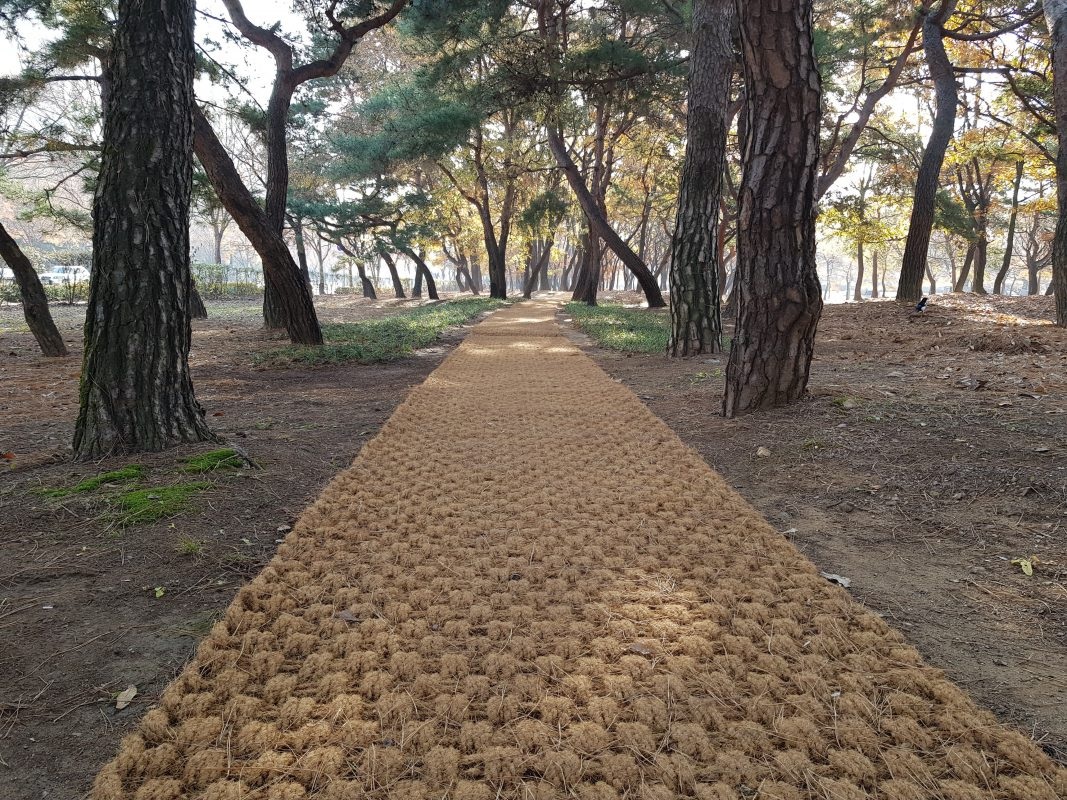
Coir geotextiles in roads – Coconut coir nets have been used for mining reclamation applications, strengthening soil from landslides, and preventing erosion of soil by water. But along with the development of technology, road paving applications use coir geotextiles. The materials are not easily weathered but do not pollute the soil because they are made of biodegradable or eco-friendly materials, namely from coconut coir side-product.
Coir geotextiles or Cocomesh model coconut coir nets used for paving roads in Korea have a slightly different design. The design of the rope is thicker than the general form of coir nets. The webbing is more sturdy and tight which can withstand the load that passes above. The common cocomesh design measures 2 x 25 meters with a rope thickness of 0.4-0.6 cm. The distance between the ropes is usually 3×3 cm or 4 x 4 cm.
The use of coir-nets to cover the prepared soil as a road is an alternative if the land is clay, wet and unstable. Strong materials and economical prices will certainly save costs.
Indonesia is a Country that Produces Coconut Products which is a Large Scale
As a tropical country, Indonesia has a large coconut production potential. The coconut plantation area reaches 3,654,478 hectares with a total production of around 3,051,585 tons (DitJenbun, 2014), 99% of which is cultivated by small farmers. In addition to being used for domestic consumption, several coconut commodities are exported which bring in foreign exchange so that these commodities can be used as a source of the national economy.
Coconut plants have many benefits such as young leaves for handicrafts, coconut flowers as a food culinary, coconut fruit for dessert and beverages, coconut tree trunks for home construction, even coconut tree roots can still be used as handicrafts, and much more. Undoubtedly, the Scout organization uses the coconut bud or coconut bud logo because of their philosophy that every part of the coconut tree can be used for human life. Likewise, scout members are expected to be useful for the Indonesian state and nation at every age.
The coconut plant is nicknamed the “Tree of Life” because all parts of the plant can be used. In Indonesia, coconut is an important plantation product because it supports millions of people and makes it a very valuable asset for the country. Coconut is a social and economic good. So that when the price of these goods changes, it has a direct impact on the lives and livelihoods of farmers.
Application of Coir Geotextiles in Roads Paving
The production of the coir geotextiles is by crushing coconut coir waste with a crusher machine. After being cut into small pieces of coir then sieved using a coir sieving machine to produce separated fibers. This fiber is then twisted with a coconut coir rope spinning machine with a diameter size that can be adjusted as needed. After the rope is formed then the coir ropes are woven to resemble a net. The density of this net can be adjusted as needed.
The material for making these coir geotextiles is cheap, easy to find, easy to apply in the field, and biodegradable. Coir geotextiles or coconut coir net can be used also for geotechnical engineering or paving and can also be used as an overlayer or innerlayer. It can protect from runoff water flow, strengthen embankments, filtration and drainage.
Coir geotextiles or coir nets are spread directly over the land to be used as roads. First, the ground is roughly leveled and then a coir-net is spread over it. Coir geotextiles is an alternative solution for paving roads because it is made from natural materials, namely coconut coir waste. The material is strong but can be degraded by the soil. It is safe for the soil ecosystem itself compared to a mixture of lime, cement, etc.
Coir geotextiles can also be used to improve poor soil nutrients because after it decomposes it becomes humus and is useful for plants. The application of coir geotextiles in roads has been successful in areas of high compressibility, sloping soils, road embankments, and soils that are at risk of abrasion and erosion.